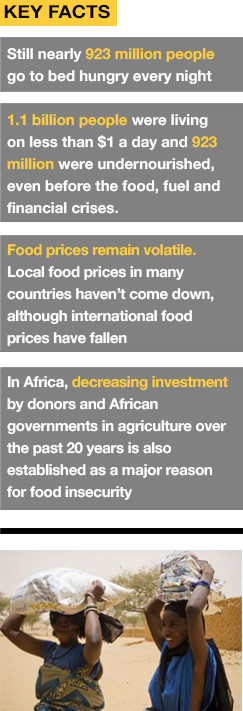
 |
|
 |
 |
 |
 |
 |
 |
 |
| What We Focus On | |||||
| Food & Agriculture |  |
|||
| Absolute poverty is a condition characterized by severe deprivation of basic human needs, including food, safe drinking water, sanitation facilities, health care, and shelter. Hunger is the number one cause of death in the world, killing more than HIV/AIDS, malaria, and tuberculosis combined. Approximately 925 million people are undernourished and cannot intake recommended daily allowances for nutrients. Despite the international efforts, such as Millennium Development Goals to reduce hunger and poverty to half by 2015, Sub-Saharan Africa is still teetering on the brink of serious food crisis. Between 2005 and 2008, staple food prices of corn and wheat rose by 83%. The pattern of food price increases highlights global hunger, pushing about 44 million people into extreme poverty. In 2012, the price of maize and soybeans rose higher than the record levels of the 2007-08 food crises, when food riots broke out in 30 countries. Wheat prices also rose higher than ever. In particular, the combined threats of drought, high food prices, displacement and chronic poverty have been affecting millions of people in the Sahel Region. Food insecurity and malnutrition are recurrent in the region with more than 16 million people directly at risk. Victims of malnutrition are mostly young mothers and children. Undernourished mothers are more likely to give births to underweight newborns, and undernourishment hamper infants’ physical and mental development threatening their lives. In 2011, 165 million children under the age 5 were stunted due to chronic malnutrition. Therefore, ensuring food security for those in poor countries is not an option, but an important objective to be achieved immediately. Promoting agriculture industry in world’s poor countries is the key to achieving food security. As the majority of the population in poor countries is engaged in the agriculture, reviving agriculture in these countries will help many people out of hunger and food insecurity. However, there are numerous obstacles, such as climate change, food price volatility, and insufficient infrastructure, to advancing the agriculture industry. For example, the price advantages of subsidized agricultural products from developed countries are recognized as one of the chief obstacles to improving agriculture in developing nations. |
 |
|||
|
GP3 Korea 2013. Creative Commons Attribution-Non Commercial-ShareAlike 2.0 License The Global Poverty Public Awareness Project in Korea. Designed by Jeong-ae Lee, Ranhee Kim, Suk-hwan Lim, Jaewoo Choi, Ji-won Oh & Seung-won Baek |